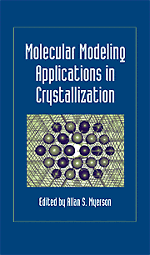Book contents
- Frontmatter
- Contents
- List of Contributors
- Preface
- 1 Introduction to Molecular Modeling
- 2 Crystallization Basics
- 3 The Study of Molecular Materials Using Computational Chemistry
- 4 Towards an Understanding and Control of Nucleation, Growth, Habit, Dissolution, and Structure of Crystals Using “Tailor-Made” Auxiliaries
- 5 Ionic Crystals in the Hartman–Perdok Theory with Case Studies: ADP (NH4H2PO4)-type Structures and Gel-Grown Fractal Ammonium Chloride (NH4Cl)
- 6 The Solid-State Structure of Chiral Organic Pharmaceuticals
- Index
4 - Towards an Understanding and Control of Nucleation, Growth, Habit, Dissolution, and Structure of Crystals Using “Tailor-Made” Auxiliaries
Published online by Cambridge University Press: 11 September 2009
- Frontmatter
- Contents
- List of Contributors
- Preface
- 1 Introduction to Molecular Modeling
- 2 Crystallization Basics
- 3 The Study of Molecular Materials Using Computational Chemistry
- 4 Towards an Understanding and Control of Nucleation, Growth, Habit, Dissolution, and Structure of Crystals Using “Tailor-Made” Auxiliaries
- 5 Ionic Crystals in the Hartman–Perdok Theory with Case Studies: ADP (NH4H2PO4)-type Structures and Gel-Grown Fractal Ammonium Chloride (NH4Cl)
- 6 The Solid-State Structure of Chiral Organic Pharmaceuticals
- Index
Summary
Introduction
Although crystals and crystallization as a process play an important role in pure and applied science, our ability to design crystals with desired properties and our control over crystallization based on structural understanding are still limited. Indeed, our ignorance of the overall process of crystal growth is brought to the fore by comparison with the controlled crystal growth provided in biomineralization. Organisms can mold crystals of specific morphologies, sizes, and orientations in the form of composites of minerals and organic materials with characteristics vastly different from those of their inorganic counterparts (Löwenstam and Weiner 1989; Addadi and Weiner 1992; Mann 1993). Nevertheless, the technological advances in controlling the microstructure of inorganic materials on the subnanometer scale have led to tremendous success in the preparation of ceramics, synthetic layered microstructures, and semiconducting materials. Paradoxically, advances in the field of organic materials have not been as striking, although the techniques for the preparation of films such as Langmuir–Blodgett and self-assembled multilayers on solid support hold promise as pyroelectric, piezoelectric, and frequency doubling devices, etc. The thread that binds these diverse topics involves molecular interactions at interfaces.
The surfaces of a growing crystal can be thought of as composed of “active sites,” which interact stereospecifically with molecules in solution, in a manner similar to enzyme–substrate or antibody–antigen interactions. The repetitive arrangements at crystal surfaces, and the knowledge we have of their structures, offer simpler means to pinpoint molecular interactions.
- Type
- Chapter
- Information
- Molecular Modeling Applications in Crystallization , pp. 166 - 227Publisher: Cambridge University PressPrint publication year: 1999
- 2
- Cited by

